So, continuing the theme of espionage, intrigue, behind-the-scenes political scandals taking place on the world stage. Devices, equipment, great minds ...
Spying is as old as the story itself. Much younger, however, is intelligence services. Spying is often called the “second oldest profession in the world.” For rulers, the use of agents has always been an important tool for protection against internal and external hazards. They wanted not to be left to the will of blind fate, but to recognize the dangers in time and be able to protect themselves from them.
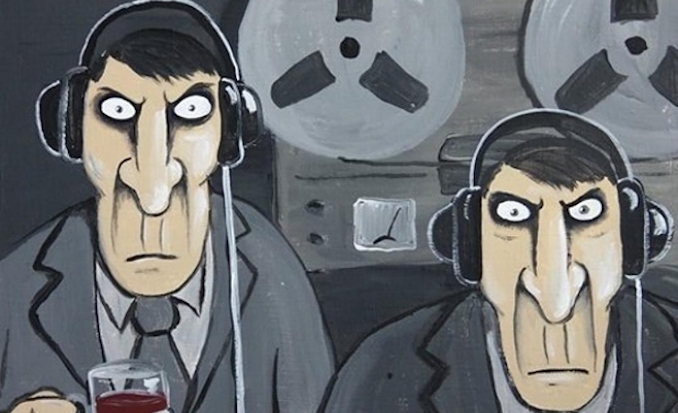 © Vasya Lozhkin
© Vasya LozhkinBoris Hagelin and his Crypto AG
Since the Second World War, Boris Hagelin and his company Crypto AG have had close relationships with the United States, especially with AFSA (later: NSA). Beginning in 1951, Hagelin and the NSA had a tacitly under-the-table agreement to weaken the cryptographic security of the company's cryptographic machines when they were sold to certain enemy countries.
Earlier there were rumors of a secret collaboration between the NSA and the Swiss company Crypto AG, founded in 1952 by the Swedish inventor Boris Hagelin. Yes, and employees of the company among the guests of production Crypto AG often observed members of the NSA, but over time, these allegations were categorically rejected, and no substantial evidence was provided. Rumors and no more.

In 2014, the NSA published 7600 documents, over 52 thousand pages of historical material on the activities of William Friedman (1891-1969) - the American cryptographer, the father of American cryptology. 400 documents contain material about Boris Hagelin and his Crypto AG. Some documents were not declassified to the end, many were edited. But why? Everything is simple: the materials could contain information capable of undermining national security, causing damage to the persons or companies mentioned in the documents.
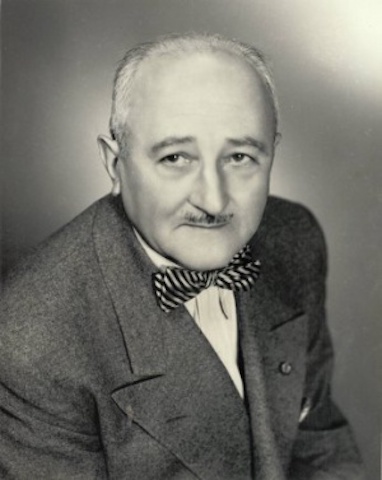 William Friedman
William FriedmanIt’s not a secret that Boris Hagelin and William Friedman were good friends. They had a lot in common, they had something in common: a passion for historical encryption machines, and, oddly enough, depressions and thoughts. During World War II and after it ended, they were in close contact with each other.
Among the published documents are several hundred letters from the correspondence of Friedman and Hagelin. Most of the letters were still personal in nature, but some of them contained material clearly related to the actions of the NSA. From the documents it becomes obvious that the AFSA (predecessor of the NSA) and Hagelin concluded some kind of agreement already in 1951. Although the agreement itself is still classified as secret, there are facts proving the existence of a secret Gentleman Agreement between the NSA and Hagelin / Crypto AG in the 1950s.
It was the Second World War (1939-1945). One of the greatest financial achievements of Hagelin was the development and sale of M-209 encryption machines for the US Army. The M-209 crypto machine was based on the C-38, a small coding machine with 6 rotary wheels, the M-209 was adapted to the requirements of the US Army. All Hagelin cryptomachines were manufactured at a factory in Stockholm (Sweden), but the Americans received a license to manufacture devices at home. It was a forced move, due to the beginning of the Second World Mass Delivery of Machines from Europe to the USA, it would be an action, at least, difficult. Hagelin decided to leave Europe and organize the production of C-38 directly overseas.
On May 10, 1940, Hagelin boarded the last ship from Europe to the USA, taking with him two copies of the C-38 crypto machine. Ultimately, these machines became the prototypes of the M-209, which soon "gained the status" of a bestseller among the C-machines ever produced by the great Hagelian mind. The release of the machines was carried out by the Corona plant of LC Smith in Syracuse, and the M-209 army was replenished by 500 units daily. Smith Corona was established in 1942 and specialized in the manufacture of typewriters.
With the drawings in the briefcase and the two disassembled encoders in the bag, we got on the Stockholm - Berlin express. We were lucky. With a crash we rushed through the very heart of Germany and three days later we arrived safely in Genoa. That night, the windows in the windows of the hotel where we stayed were broken - we accidentally decided to stay at the London Hotel, and Italy was already at war with England. But we still managed to go to New York with the last flight of the ship, sailing from Genoa.
The image is a typical M-209 during the Second World War. She had 6 rotary wheels in the front, each with a different number of steps.
 M-209
M-209Since Hagelin was never able to return to Sweden during the war, he remained in the USA, where he was engaged in the BC encryption machines. About 50 thousand M-209 cryptomachines were produced, and for the entire production time - 140 thousand such encoders. Converter M-209 was massively used in the army during hostilities and after the war.
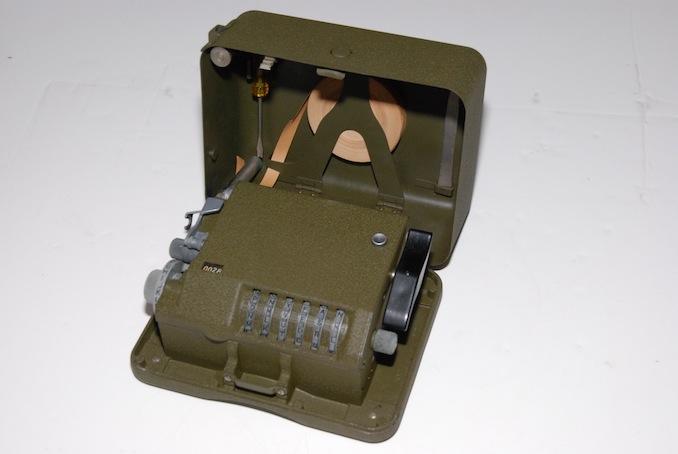
To set up production of M-209 and BC-38 directly in the USA and not to pay high taxes in Sweden, Hagelin transferred the full and gratuitous patent rights of the US Army, receiving more than $ 3 million, of which 2.5 million were intended personally for the scientist. About $ 475,185 entered the balance of the Hagelin Cryptograph Company (HCC) in Sweden. From the US government, Hagelin was granted a free license, allowing to produce and improve the M-209 and BC-38 cars.
It is worth noting that the car did not provide absolute secrecy. During World War II, the Germans could decode a message in less than 4 hours. To say that this was a problem would not be correct, since the M-209 was used only for tactical communications (for example, field maneuvers), which in a couple of hours had already lost their meaning. Popular M-209 was due to its small size and ease of use. In just a couple of hours of use, the operator learned the principles of its work. The text was entered one letter at a time, the rotor with the alphabet (on the left) was set to the desired position, the black pen was turned (on the right) one full turn, and voila ... the letter was printed on paper tape.
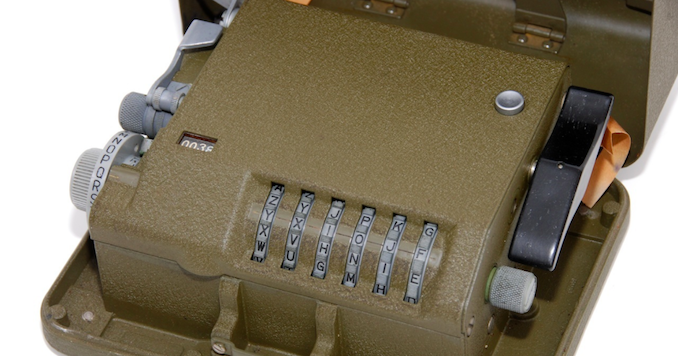
One of the greatest strengths of the M-209 was its completely mechanical “nature”; it did not require electricity or any other power source. Cryptomachine stopped using after the Vietnam War.
Shortly after World War II, in 1947, many M-209 machines that were no longer needed by the US Army appeared on the market at a ridiculous price — below $ 15. On November 2, 1947, in a letter to Friedman, Hagelin expressed his concern about the fact that the Dutch Procurement Commission purchased the first sample of M-209 and ordered another 100 units, since all of this could have a negative impact on Hagelin’s business in Europe, rather undermine his position and sales. Friedman reassured the scientist in the letter, referring to the fact that this might be some kind of mistake. As a result, the Dutch received a hundred copies (from the letter of Hagelin to Friedman on February 24, 1947).
This question clearly worried Hagelin, two weeks later, on December 13, he again appealed to Friedman to investigate the Automatic Radio Manufacturing Company in Boston, which allegedly sold M-209 A for only $ 2. Hagelin did not yet know that the US was already ready to sell the 450 M-209 encoders for $ 2 to the Dutch army.
New Developments 1950
Immediately after the end of the Second World War, Hagelin decided to improve the existing encryption machines by adding new features and, importantly, by increasing the level of security of the devices by introducing irregular stepping of encryption rotors.

Already in August 1950, Hagelin wrote to Friedman about the release of new cryptomachines. October 5, 1950 Hagelin filed a patent for a new car. In early 1951, a new mechanism of manipulation (irregular / random stepping) was ready. In Stockholm, at this time, work was underway to develop another machine - an automatic cipher machine for teleprinters. At the heart of it is a mechanical C series machine, used to create a 5-bit pseudo-random code that was mixed with plain text.

In addition to the mechanical mechanism of the C-line, the machine was equipped with a 5-level tape reader. A tape recorder could be supplemented with a random-key tape, allowing you to use the machine as a One-Time Pad (OTP) or One-Time Tape. When used properly, the OTT system was theoretically indestructible and provided the best information protection.
In February 1951, a prototype with a new manipulation mechanism based on an improved M-209 was sent from Stockholm to AFSA for evaluation. New technology has brought a lot of noise, as the Americans were afraid that the device could fall into the hands of "competitors" if Hagelin wants to sell it to the USSR. The situation was discussed at the meeting of the USCIB on March 9, 1951 and on May 22, 1951 at a meeting in AFSA. Negotiations were conducted with Hagelin himself. Although most of the report is still secret, you can extract the following from it:
- at that time Hagelin was the only civilian manufacturer of encryption machines in the world
- AFSA considered Hagelin to be a serious international player
- AFSA viewed Hagelin as a security risk
- AFSA considered Boris Hagelin a good and loyal companion,
- The US wanted to prevent the development of new technology,
- Hagelin's technology has been considered for use by NATO,
- Hagelin's OTT technology is useful for NATO.
At present, it is not fully known whether the deal was actually signed between AFSA and Hagelin, but from the surviving documents and the correspondence of Friedman and Hagelin, it can be assumed that it did take place.
On September 14 in 1951, matters between the parties deteriorated. Hagelin's patent for a new technology cost $ 188,546, and information about it is classified as “secret” by order of AFSA. Surprisingly, the patent was miraculously sold to 10 other countries in which the United States did not have its jurisdiction, therefore the secrecy of the new technology was no longer so “secret”. On March 27, 1952, the head of the AFSA Communications Security Office asked for a review of relations between the US and Hagelin. The situation with the M-209 has not been resolved. In October 1953, the United States received requests for the release of M-209 cars from several countries.
Philippines . On June 12, 1951, the US Army supplied 229 M-209 cryptomachines for the Philippine Armed Forces with the consent of AFSA in addition to the 369 units that were already there at that time.
Uruguay . On October 6, 1952, the Uruguayan government wanted to buy 36 M-209 units, but this request was rejected on October 14, 1952, stating that the equipment was no longer available for sale.
India On March 16, 1951, India applied for the purchase of M-209, M-209a and M-209b cryptomachines, but they wanted to get copies of the manuals for TM 11-380. The request has been rejected.
France On September 23, 1952, France requested 450 M-209 converters in addition to the 1,850 units that were in use at the time. The request was rejected for several reasons. On September 22, 1953, France again requested 350 units for use in Indochina. This request was also dissatisfied with the NSA, as it jeopardized the ongoing negotiations between the NSA and Hagelin in Sweden. Restrictions on the supply of cars to France were subsequently canceled on January 12, 1954, after coordinating this issue with Boris Hagelin.
Portugal On June 23, 1953, Portugal requested permission to supply the upgraded M-209b, but this request was legitimately denied.
Turkey On August 16, 1950, the Turkish army requested permission to purchase M-209 vehicles. The request was rejected, but the American CSP-845 was proposed as an alternative. On May 22, 1953, Turkey requested 600 units of M-209, but the attempt was unsuccessful. At this time, the reason for the refusal was banal - the stocks of M-209 in the USA were exhausted.
Latin America . M-209 was used by the governments of Ecuador (1947), Venezuela (1948), Argentina, Colombia and Peru (1951).
1954 Meanwhile, Hagelin perfected his cryptomachines and was ready to launch the release of new cryptography masterpieces. The first was the C-52. Something similar to the M-209, but with interchangeable rotors. After it followed the CX-52 with a new mechanism of manipulation. There was an opportunity to choose up to twelve different rotors. The machine operated with 26 letters of the Latin alphabet, each rotor was divided into a different number of segments and moved randomly.
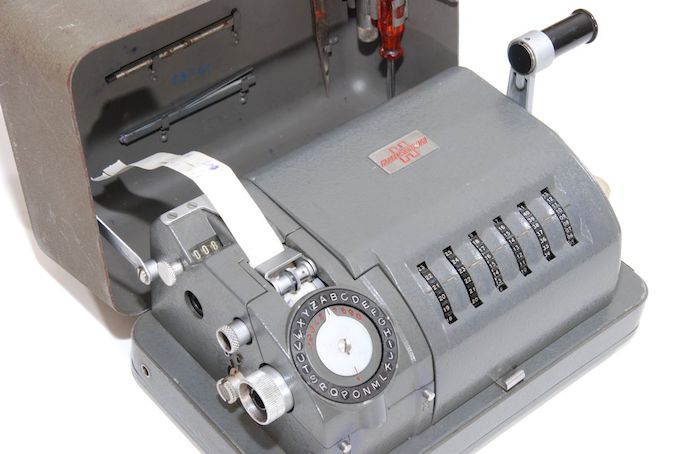 C-52
C-52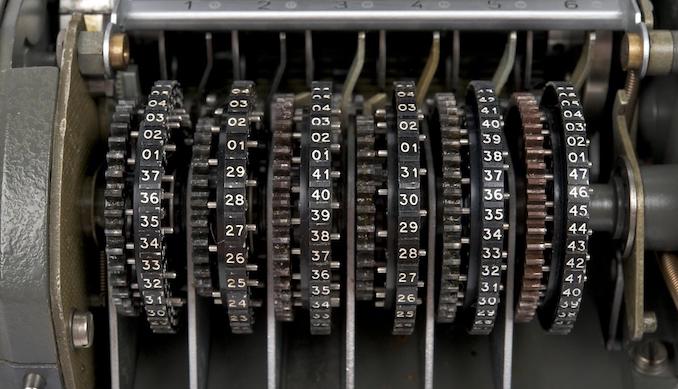
On the memorandum (February 5, 1954), the NSA expressed their concern about the recently released Hagelin machines, in particular the CX-52, TC-52 and the upcoming release of the TC-55. Friedman was invited to contact the Hagelins and make an offer on behalf of the director of the NSA (DIRNSA). In addition, Friedman was told to use his personal address for correspondence. As it should be at that time, the Gentlemen’s Agreement was concluded, the details of which are still classified as secret. In February 1955, Friedman went to Zug (Switzerland) for a personal visit to Boris Hagelin with the firm intention to make a scientist a new proposal.
On February 21, 1955, Friedman arrived in Zug (Switzerland), staying at Hagelin's house. They discussed business and personal issues all week. Boris Hagelin's son also attended some meetings. Friedman tried to find out about the differences between the variants of the cars and about the customers who sell these cars. In the end, he made Hagelin a charged offer.
The following information was extracted from a report that Friedman filed upon returning to the United States on March 15, 1955. Unfortunately, most of this report has been edited, here is the general information from this agreement: Hagelin agreed not to sell certain versions of his cars to some countries, the NSA will write the manual for the machines used in NATO, Hagelin will receive orders from NATO for the machines in the transaction -52 and CX-52.
From the moment of his arrival at 22, it was clear to Friedman that relations between Boris Hagelin the elder and his son Bo were strained, to put it mildly. The younger Hagelin on arrival in the United States began to sell encoders for Latin American countries and spent too much money, even asked his father for an advance in the share of the inheritance (about 25 thousand US dollars). Hagelin sent 30 thousand dollars to his son in Washington. Parents blamed American wife Bo for everything, because of her, he cannot / does not want to go back to Europe.
Hagelin shared with Friedman his intention to merge his business with Siemens. And also about the decision to finally transfer the production of machines from the Stockholm factory to Zug, so that all development and operations were conducted in one location. Moreover, workers in Stockholm were allowed to move to Zug.
The plant in Stockholm (Sweden) produced line C of machines (C-52 and CX-52) in the amount of 60 to 80 cars per month. In addition to these machines, the Stockholm plant also received orders for the production of 500-1000 C-446 cryptomachines. In Zug, where he intended to transfer all Hagelin facilities, the upper floor of the new building was converted into a residential apartment for Sture Nyberg and his family (plant manager in Stockholm).
C-446
The news of the resumption of the release of the old C-446 for wholesale sales to other countries clearly did not make Friedman happy.
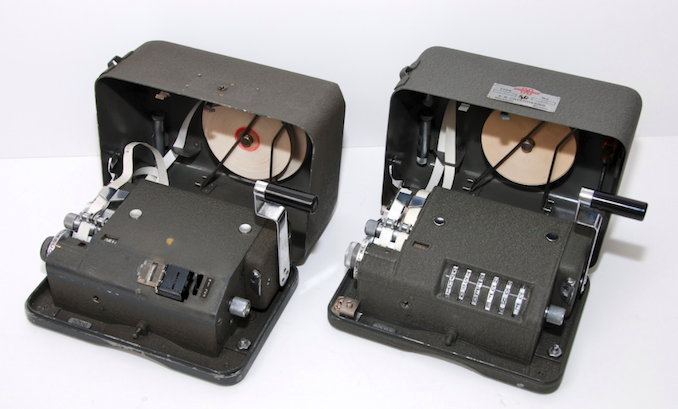 C-446
C-446C-446 was a mechanical cipher machine, developed by Boris Hagelin and released into production in Stockholm (Sweden, 1946). The machine was designed based on the C-38 (M-209), it had two printers on the left: one for plain text and one for encryption. The C-446 has been used by many armies around the world, including Norway and the Netherlands. The car was compatible with C-38, M-209, BC-38 and later BC-543.

Unlike M-209, which had a fairly simple locking method, the C-446 was blocked by two different keys; one for the user and one for the officer. Three versions of C-446 were known: C-446, C-446-A, C-446-RT. C-446 was supplied in two colors: gray for commercial purposes and green for the military. In addition to coloring, they are no different (in terms of functionality).
One of the goals of Friedman’s visit to Zug is to find out which models Hagelin sells to its customers. Surprisingly, Hagelin provided a customer base and information about the machines that were sold or were in the process of being delivered. And so - the list looked like this:
- Egypt - 50 x C-52 and 10 x BC-52
- Jordan - 10 x C-52, 20 x BC-52
- Iraq - negotiations were being held on the supply of 50-200 x C-52 with Arabic alphabet
- Syria - 50 x C-36
- India - was interested in buying C-52 and BC-52
- Belgium - 200+ x CX-52a
- France - 80 x CX-52a, 20 x CX-52a / 10 of which for training
- Portugal - 5 x CX-52a
- Holland - from 500 to 1000 x C-446, some OTT (C-446 / RT)
- England - 2 x CX-52
- Indonesia - Expected order for delivery from 20 to 30 x C-52
- Poland and Hungary - 2 x C-446
- Costa Rica - 2 x C-446
- Brazil - 60 x CX-52c, were interested in another 500+ copies
- Argentina - 13 x CX-52c
- Peru - 200 x CX-52
- Uruguay - 5 x CX-52, 2 x BC-52
- Colombia - 100 x CX-52, 40 x BCX-52
Upon returning from Zug to the USA, Friedman suffered a heart attack, he was hospitalized, it put off indefinitely the fulfillment of some points of the agreement with Hagelin. After being discharged from the hospital, Friedman worked from home and corresponded with a friend. In 1955, Friedman left the service in the NSA, continued to work as a consultant. Instead, Sinn has now begun negotiations.
Dr. Sinn visited Hagelin several times and exchanged information with him, while constantly keeping Friedman in the know, sending him copies of the reports. Hagelin was not too pleased with Sinn, in 1956 he was replaced by Friedman's colleague - Howard Barlow.In 1957, at the request of Hagelin, Friedman once again went to Zug for negotiations. This week, Hagelin briefly went to Paris to meet with the French army, where he received a large order for the production of encryption machines. Upon his return, he reported his relations with the French to Friedman. In the absence of Hagelin, Friedman visited the factory and laboratory, demonstrated the latest developments. Hagelin and Friedman talked for a long time, addressing various topics related not only to cryptology.Friedman and Hagelin spent a lot of time discussing Siemens and using their OTT equipment. Hagelin heard that Siemens was going to sell the OTT generator to the country behind the Iron Curtain, and he wanted to find out if this was true. He learned that the German government had provided Siemens with the green light to sell its One-Time-Tape generator to encryption to other countries (except the USSR).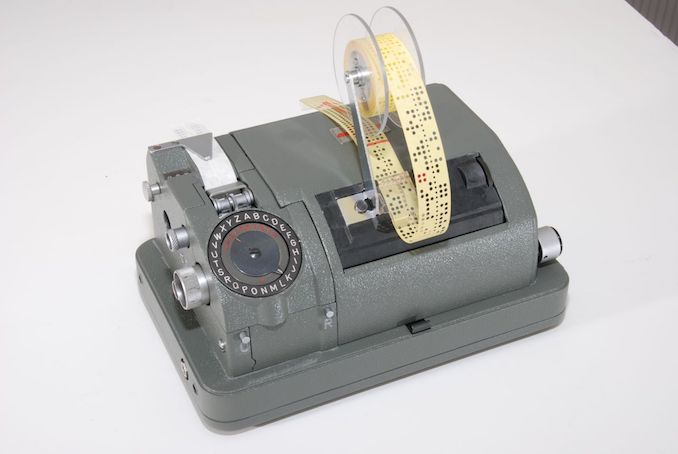
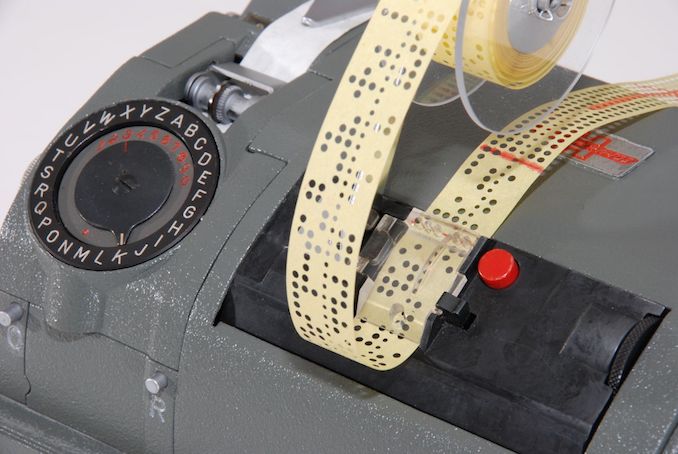
Hageling Handhelds
Pocket encryption devices, which Hagelin spoke at the first meeting with Friedman (1955), were ready for the second meeting and went into production. There are two different versions: CD-55 and CD-57, almost identical. The CD-55 was available to all customers in all countries in the green package. The operation of such a device was similar to the operation of the C-38, C-446 and M-209.The second option is the CD-57, which was developed using a new manipulation mechanism, similar to that used in the CX-52. In addition, the CD-57 could easily be “converted” into a One-Time-Tape machine.The CD-57 in the gray package was available for sale only to NATO countries and friendly countries in relation to NATO. Initially, the device was supposed to have a built-in printer, but in the end the final version came out without a printer. The operator is now reading data from the rotor with the alphabet placed in front. The rotors themselves were made of aluminum, not plastic.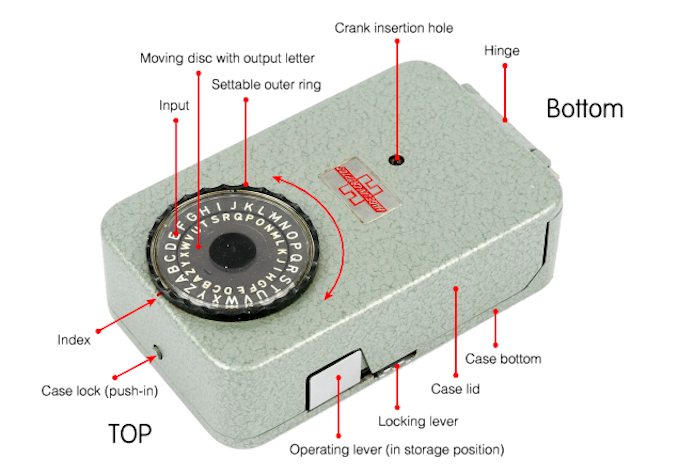
1958-1993
In subsequent years, Fridman’s health deteriorated, he often lay in the hospital, in the following years he couldn’t visit Hagelin in Europe for health reasons, he worked mostly from home. Financial difficulties did not allow him to travel at his own expense, and the agency did not send him on business trips to Hagelin. In 1962, Friedman decided to leave for Zug (Switzerland) and work with Boris Hagelin. There were moments when he even thought about moving to Europe forever.Upon his return to the United States, Friedman worked on notes in which he covered Hagelin’s biography, but recurring health problems prevented him from completing what he had begun. November 29, 1966 Hagelin's wife, Annie, died. In May 1968, Hagelin planned a trip to the United States, in his plan - a visit to Friedman's house. Ahead, there was a story about production in Zug and about new technologies, such as integrated circuits. Unfortunately, on October 8, Friedman suffered another heart attack, so they took place in hospital walls in Washington. The next 10 years, the relationship between Boris and his son Bo was not reputed to be too good, to say the least. They sometimes corresponded, each was busy with his business.In November 1969, Friedman died at the age of 78. Unfortunately, Bo died a year after Friedman, he died in a fatal car accident, shortly after these events, Boris Sr. resigned, retired from the board of Crypto AG, a few years later finished his memoirs (1979), originally in German, later in English (1981). He died on September 7, 1983, at the age of 91, leaving a huge legacy. Over the years, Hagelin has created beautiful and ingenious masterpieces of mechanical, electrical and electronic equipment. Boris Hagelin built a large company with a huge client base around the world. The aforementioned story is the result of extensive research by Friedman’s official documents from the Air Force and the Crypto Museum in July 2015.Watergate scandal 1971-1972
In 1972, the Watergate scandal led to the resignation of US President Richard Nixon. The Stasi is not the only agency that used the Tessina camera for espionage. During a Watergate hack on June 17, 1972, FBI investigators found a black Tessina cell in the United States at one of the participants in the so-called “Plumbers”. The cell was confiscated by the police as evidence for a trial. The secret group The Plumbers under US President Nixon was supposed to determine the sources of information leaks. Nevertheless, members of The Plumbers, as it turned out, in the course of searching for sources of leakage themselves repeatedly broke the law. They broke into the DNC (Democratic National Committee) headquarters at the offices of Watergate in Washington, DC, which eventually turned into a famous Watergate scandal. Several people were involved in the Watergate scandal, including E. Howard Hunt, G. Gordon Liddy, James McCord and CIA member Liason John Paisley. The involvement of the latter led to the suggestion that the CIA had a relation to the operations being conducted, more than originally intended. One of the groups, Howard Hunt, used the Tessina camera developed by the CIA to photograph Dr. Fielding’s office on August 25, 1971.
Several people were involved in the Watergate scandal, including E. Howard Hunt, G. Gordon Liddy, James McCord and CIA member Liason John Paisley. The involvement of the latter led to the suggestion that the CIA had a relation to the operations being conducted, more than originally intended. One of the groups, Howard Hunt, used the Tessina camera developed by the CIA to photograph Dr. Fielding’s office on August 25, 1971.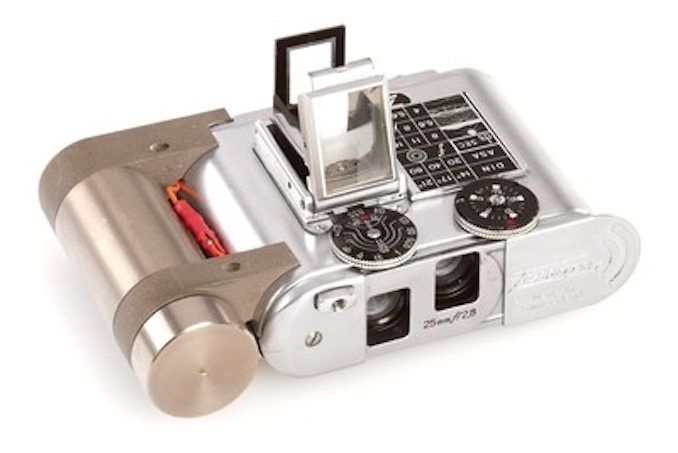
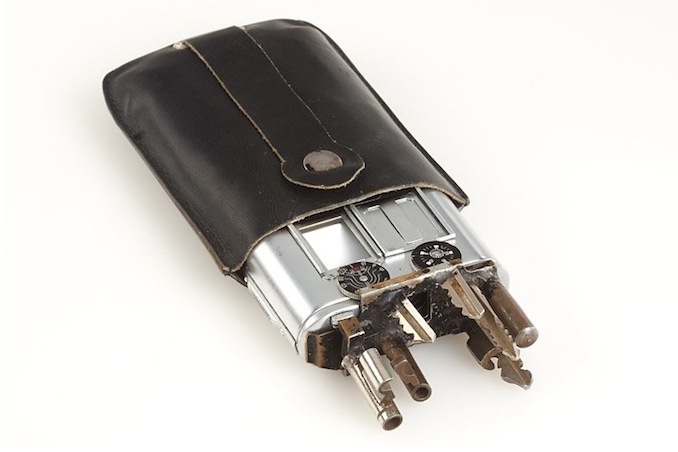 The Tessina 35 is the smallest miniature camera ever created with a standard 35 mm film. It is even smaller than the Minox 35, it could be worn on the arm, like a watch. The camera was patented by an Austrian chemical engineer, Dr. Rudolp Steiniek in Lugano (Switzerland) and made by Sigrist in Grenc (Switzerland). The camera was introduced to the world in 1957, it was sold by the company Concava SA (Shtainek in Lugano), remained in production until 1996.The extremely compact camera with dimensions of 65 x 50 x 20 mm was a bit larger than a matchbox, it could be hidden by hiding it in a cigarette pack or a woman's handbag. It was possible to turn the camera into a fashionable accessory by adding a leather belt and putting it on your arm like a watch.The camera was available in various colors: red, gold and black, but the most popular version was a camera in a chrome body. The bracelet was available in brown and black leather.Tessina had two 25 mm f / 2.8 lenses: one for shooting and one for projecting an image onto a standard 35 mm (14 x 21 mm) frame using an internal 45-degree mirror. The camera could shoot only when the lens cover is fully opened.
The Tessina 35 is the smallest miniature camera ever created with a standard 35 mm film. It is even smaller than the Minox 35, it could be worn on the arm, like a watch. The camera was patented by an Austrian chemical engineer, Dr. Rudolp Steiniek in Lugano (Switzerland) and made by Sigrist in Grenc (Switzerland). The camera was introduced to the world in 1957, it was sold by the company Concava SA (Shtainek in Lugano), remained in production until 1996.The extremely compact camera with dimensions of 65 x 50 x 20 mm was a bit larger than a matchbox, it could be hidden by hiding it in a cigarette pack or a woman's handbag. It was possible to turn the camera into a fashionable accessory by adding a leather belt and putting it on your arm like a watch.The camera was available in various colors: red, gold and black, but the most popular version was a camera in a chrome body. The bracelet was available in brown and black leather.Tessina had two 25 mm f / 2.8 lenses: one for shooting and one for projecting an image onto a standard 35 mm (14 x 21 mm) frame using an internal 45-degree mirror. The camera could shoot only when the lens cover is fully opened.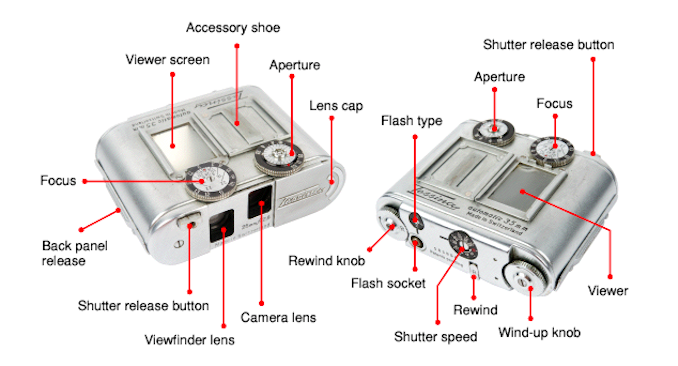 The camera remained in production until 1996, the release of devices was stopped only because of an increase in production costs. The price of the camera in 1996 was about 1000 euros. Tessina was so small that it could be used completely unnoticed.Although the dimensions of the Minox miniature cameras were smaller, they were less suitable for unobtrusive outside viewing.
The camera remained in production until 1996, the release of devices was stopped only because of an increase in production costs. The price of the camera in 1996 was about 1000 euros. Tessina was so small that it could be used completely unnoticed.Although the dimensions of the Minox miniature cameras were smaller, they were less suitable for unobtrusive outside viewing.
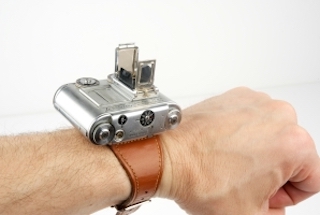 The most popular way to hide a Tessina camera is inside a regular pack of cigarettes. If you pull out the viewfinder and the socket for the flashlight, the camera would fit perfectly in a pack from under the cigarettes, leaving room for fake cigarettes. The camera could be controlled from the inside of the cigarette case: tiny holes were drilled in the side of the case, which allowed the camera lens to “see through it”. The spy could quietly smoke a cigarette, taking pictures.
The most popular way to hide a Tessina camera is inside a regular pack of cigarettes. If you pull out the viewfinder and the socket for the flashlight, the camera would fit perfectly in a pack from under the cigarettes, leaving room for fake cigarettes. The camera could be controlled from the inside of the cigarette case: tiny holes were drilled in the side of the case, which allowed the camera lens to “see through it”. The spy could quietly smoke a cigarette, taking pictures.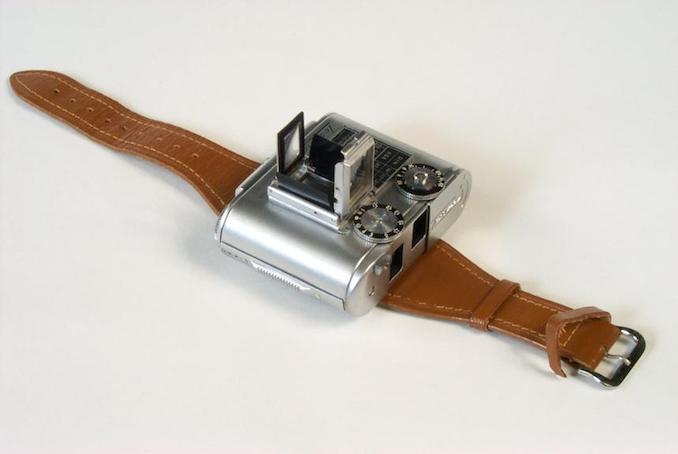 The camera was very popular for observations during the Cold War with the Stasi, the secret police of the former GDR (East Germany). Many ways have been developed to hide the camera in handbags, cigarette cases, etc. It was popular to wear a camera on a strap (like a watch), it could easily be hidden in a coat sleeve, just as if it were a big wrist watch. This strap consisted of a metal mount and two leather straps.
The camera was very popular for observations during the Cold War with the Stasi, the secret police of the former GDR (East Germany). Many ways have been developed to hide the camera in handbags, cigarette cases, etc. It was popular to wear a camera on a strap (like a watch), it could easily be hidden in a coat sleeve, just as if it were a big wrist watch. This strap consisted of a metal mount and two leather straps.Operation Shooter
 For eight years, the Soviet Union spied on the United States, listening to IBM Selectric typewriters in the Moscow embassy. The bug "collected" the text typed on the machine, and sent short radio messages to the nearby listening post. The bugs were difficult, they could not be detected by conventional TSCM methods or during a search.The Selectric Bug / Bug is a sophisticated digital listening device developed in the mid-1970s by the Soviet Union (USSR). The bug was built into the IBM Selectric II and III typewriters and was almost invisible, not detected even during searches. In 16 typewriters, bugs were found and used for at least 8 years at the US Embassy in Moscow and the US Consulate in Leningrad.
For eight years, the Soviet Union spied on the United States, listening to IBM Selectric typewriters in the Moscow embassy. The bug "collected" the text typed on the machine, and sent short radio messages to the nearby listening post. The bugs were difficult, they could not be detected by conventional TSCM methods or during a search.The Selectric Bug / Bug is a sophisticated digital listening device developed in the mid-1970s by the Soviet Union (USSR). The bug was built into the IBM Selectric II and III typewriters and was almost invisible, not detected even during searches. In 16 typewriters, bugs were found and used for at least 8 years at the US Embassy in Moscow and the US Consulate in Leningrad.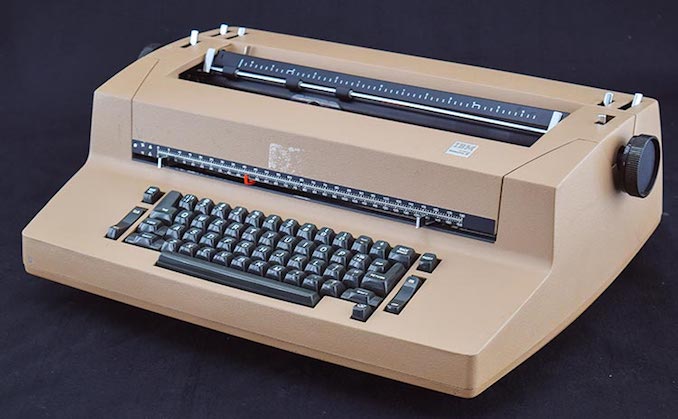 The digital listening device was built into a recess on a metal base plate that moved from left to right inside an IBM typewriter. The principle of work of the bug was built on the movements of the writing head, while typing the head turned in a certain direction, exclusive for each character on the keyboard. Americans have found at least 5 versions or generations of bugs. Some were powered from the AC source, others from DC.The devices were controlled remotely. When the typewriter was turned on, the device was activated and transmitted data over the radio in short bursts to the nearest point of interception. Despite some ambiguity of the intercepted data, the Soviets could restore the “clean” source code.
The digital listening device was built into a recess on a metal base plate that moved from left to right inside an IBM typewriter. The principle of work of the bug was built on the movements of the writing head, while typing the head turned in a certain direction, exclusive for each character on the keyboard. Americans have found at least 5 versions or generations of bugs. Some were powered from the AC source, others from DC.The devices were controlled remotely. When the typewriter was turned on, the device was activated and transmitted data over the radio in short bursts to the nearest point of interception. Despite some ambiguity of the intercepted data, the Soviets could restore the “clean” source code.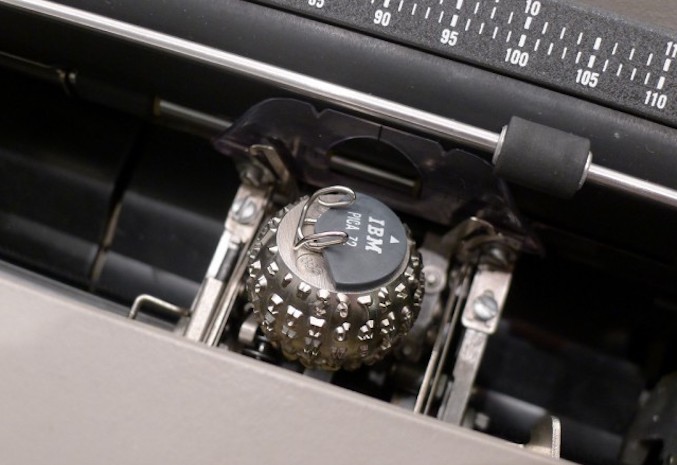 The first bug was discovered after a similar “thing” was found in a teleprinter in the French embassy (intelligence) in 1983. United States launched a secret project GUNMAN, whose goal was to search for any bugs. 11 tons of equipment was withdrawn from the US Embassy in Moscow, all sent to the NSA (USA) for research.The bug was quite large and consisted of modern integrated circuits and single-bit memory. It was hidden inside the support bracket at the bottom of the keyboard mechanism, and was invisible not only to the eye, but also to the equipment of that era. Only an x-ray scan could detect the presence of bugs.
The first bug was discovered after a similar “thing” was found in a teleprinter in the French embassy (intelligence) in 1983. United States launched a secret project GUNMAN, whose goal was to search for any bugs. 11 tons of equipment was withdrawn from the US Embassy in Moscow, all sent to the NSA (USA) for research.The bug was quite large and consisted of modern integrated circuits and single-bit memory. It was hidden inside the support bracket at the bottom of the keyboard mechanism, and was invisible not only to the eye, but also to the equipment of that era. Only an x-ray scan could detect the presence of bugs. BM Selectric writing headSelectric Bug can be considered one of the first keyloggers - a small device installed between a computer and a keyboard. The keylogger caught the magnetic energy from the movement of the carriage and converted it into a digital signal.Because the NSA did not trust either the State Department or the CIA, and the issue needed to be resolved properly, a plan was developed: over the next few months, find, assemble, replace, and examine all the equipment (cars) at the US Embassy in Moscow. The top-secret GUNMAN project was approved by President Ronald Reagan in record time in February 1984. During the following months, a list of all the equipment of the embassy was compiled, which needed to be replaced, and procedures were started for the delivery of new identical equipment as soon as possible without drawing attention.To replace the NSA devices, only 50 typewriters (instead of the required 250) IBM Selectric (40% from the manufacturer) were obtained, 60% were collected from themselves and other agencies. As a result, it was decided to replace only those cars that were used in the most strategic cabinets / premises of the embassy. The whole operation was carried out with utmost care and secrecy. Even in the NSA, only the employees who directly participated in it were aware of the operation. In the spring, the cargo was delivered to the US Embassy in Moscow. Interestingly, the elevator at the embassy these days did not work, it was turned off for preventive maintenance. 10 tons of equipment had to be manually lifted to the attic, from where over the next 10 days it was distributed to various offices.
BM Selectric writing headSelectric Bug can be considered one of the first keyloggers - a small device installed between a computer and a keyboard. The keylogger caught the magnetic energy from the movement of the carriage and converted it into a digital signal.Because the NSA did not trust either the State Department or the CIA, and the issue needed to be resolved properly, a plan was developed: over the next few months, find, assemble, replace, and examine all the equipment (cars) at the US Embassy in Moscow. The top-secret GUNMAN project was approved by President Ronald Reagan in record time in February 1984. During the following months, a list of all the equipment of the embassy was compiled, which needed to be replaced, and procedures were started for the delivery of new identical equipment as soon as possible without drawing attention.To replace the NSA devices, only 50 typewriters (instead of the required 250) IBM Selectric (40% from the manufacturer) were obtained, 60% were collected from themselves and other agencies. As a result, it was decided to replace only those cars that were used in the most strategic cabinets / premises of the embassy. The whole operation was carried out with utmost care and secrecy. Even in the NSA, only the employees who directly participated in it were aware of the operation. In the spring, the cargo was delivered to the US Embassy in Moscow. Interestingly, the elevator at the embassy these days did not work, it was turned off for preventive maintenance. 10 tons of equipment had to be manually lifted to the attic, from where over the next 10 days it was distributed to various offices.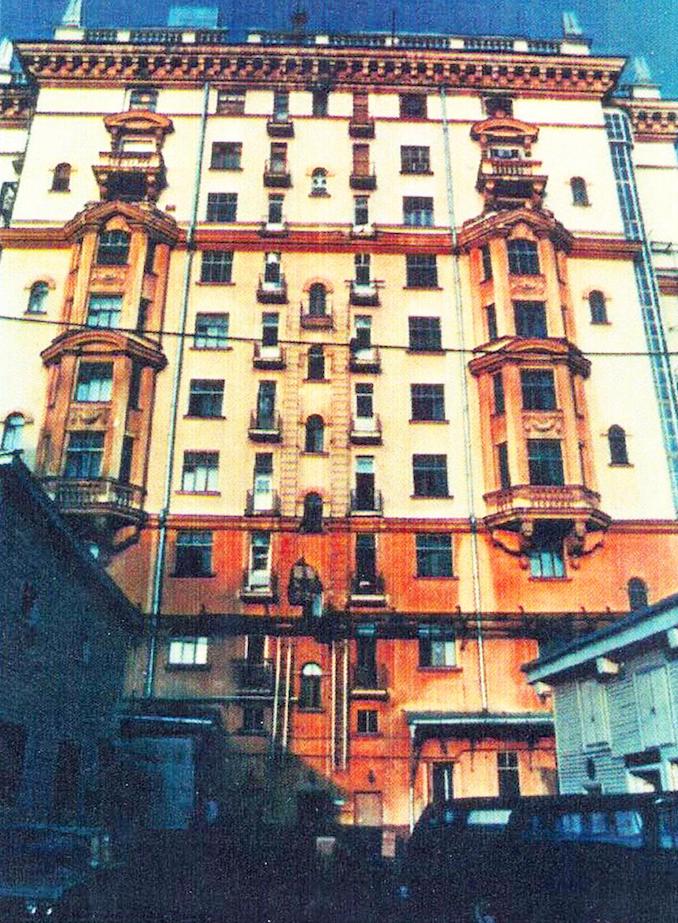 After delivering the equipment withdrawn from the embassy to the NSA, the lengthy and tedious process of examining each individual machine began. To test each printed circuit board was drawn out and subjected to x-ray irradiation. The image on the right is one of the X-ray machines during the check of the KW-7 cipher board.
After delivering the equipment withdrawn from the embassy to the NSA, the lengthy and tedious process of examining each individual machine began. To test each printed circuit board was drawn out and subjected to x-ray irradiation. The image on the right is one of the X-ray machines during the check of the KW-7 cipher board.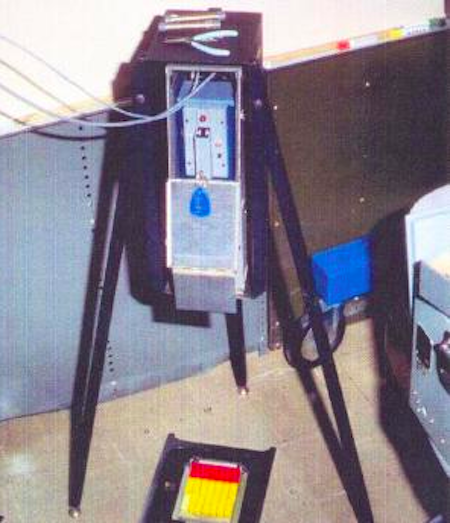 After irradiation, the schemes were compared with the available schemes, and a reward of $ 5,000 was offered to the first specialist who would have found the listening device. On the evening of July 23, 1984, technician Michael Arneson noticed an anomaly in the power switch of the IBM Selectric typewriter and decided to take an X-ray of the entire machine. To his surprise, he noticed a large number of electronic circuits in the keyboard area and immediately realized that he came across a bug. The next morning, the find was confirmed by Michael’s colleagues, therefore the cash bonus was his.
After irradiation, the schemes were compared with the available schemes, and a reward of $ 5,000 was offered to the first specialist who would have found the listening device. On the evening of July 23, 1984, technician Michael Arneson noticed an anomaly in the power switch of the IBM Selectric typewriter and decided to take an X-ray of the entire machine. To his surprise, he noticed a large number of electronic circuits in the keyboard area and immediately realized that he came across a bug. The next morning, the find was confirmed by Michael’s colleagues, therefore the cash bonus was his. A total of 16 Soviet bugs were found in twelve IBM Selectric II and four in IBM Selectric III (1984).
A total of 16 Soviet bugs were found in twelve IBM Selectric II and four in IBM Selectric III (1984).How it worked
When the operator pressed a key, the IBM Selectric printhead turned and bent - the necessary letter appeared on the paper. The head in the form of a ball or ball had four rows of 22 characters (24 characters in a later version of Selectric III). The combination of height and angle of rotation of the print head was unique for each individual letter. One half of the head was used for lowercase characters, while the other half contained uppercase characters.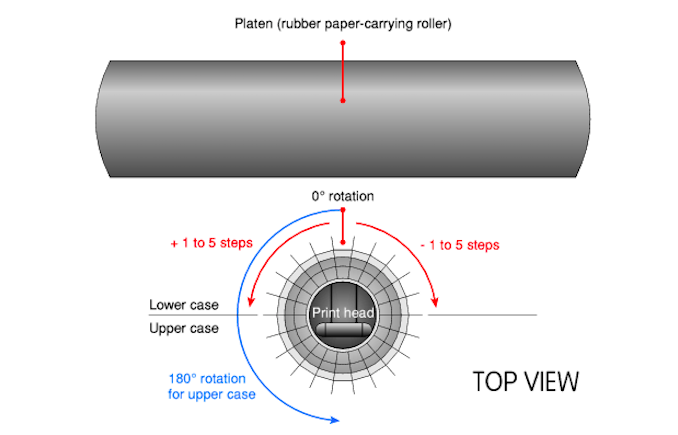 There were 4 possible levels of inclination; one for each line of 22 characters. The inclination and rotation were controlled by mechanical levers, after which the signal was transferred to digital.
There were 4 possible levels of inclination; one for each line of 22 characters. The inclination and rotation were controlled by mechanical levers, after which the signal was transferred to digital. While pressing a key (blue in the image), its keyboard lever (yellow) pressed on the so-called interpozer (orange), which had 7 protrusions (gaps) below. Interpozer for each key were different. After pressing the key, the interposer device moved forward, and each protrusion (if any) “pushed” one of the seven handrails (purple) forward. Six of the handrails were responsible for the movement of the print head, 7 was designed for special functions such as Shift, Carriage Return and Backspace. One of the 6 handrails (which was activated) moved the corresponding lock (red) forward; the inclination or rotation of the print head depended on it. The retainers were replaced by identical boards with a strong magnet at the end (marked in green). Bugs were quite complex devices, each had a magnetometer,which converted mechanical energy (from keystrokes) to magnetic perturbations.
While pressing a key (blue in the image), its keyboard lever (yellow) pressed on the so-called interpozer (orange), which had 7 protrusions (gaps) below. Interpozer for each key were different. After pressing the key, the interposer device moved forward, and each protrusion (if any) “pushed” one of the seven handrails (purple) forward. Six of the handrails were responsible for the movement of the print head, 7 was designed for special functions such as Shift, Carriage Return and Backspace. One of the 6 handrails (which was activated) moved the corresponding lock (red) forward; the inclination or rotation of the print head depended on it. The retainers were replaced by identical boards with a strong magnet at the end (marked in green). Bugs were quite complex devices, each had a magnetometer,which converted mechanical energy (from keystrokes) to magnetic perturbations.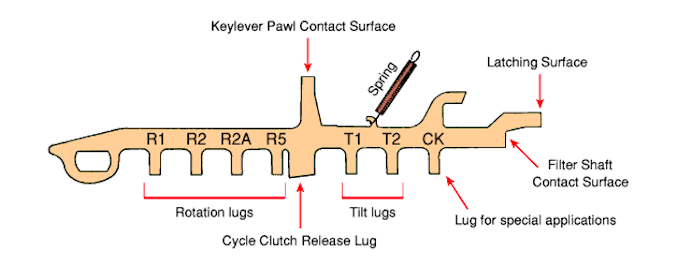 Data from 6 magnetometers (that is, 6 bits) was somehow compressed digitally into 4-bit words and then stored in a buffer that held up to 8 such 4-bit words. After the buffer was filled, the data was sent by a low-power transmitter at high speed to the receiver at the nearest wiretap point. A simplified block diagram is an assumption of how the scouts could work.
Data from 6 magnetometers (that is, 6 bits) was somehow compressed digitally into 4-bit words and then stored in a buffer that held up to 8 such 4-bit words. After the buffer was filled, the data was sent by a low-power transmitter at high speed to the receiver at the nearest wiretap point. A simplified block diagram is an assumption of how the scouts could work.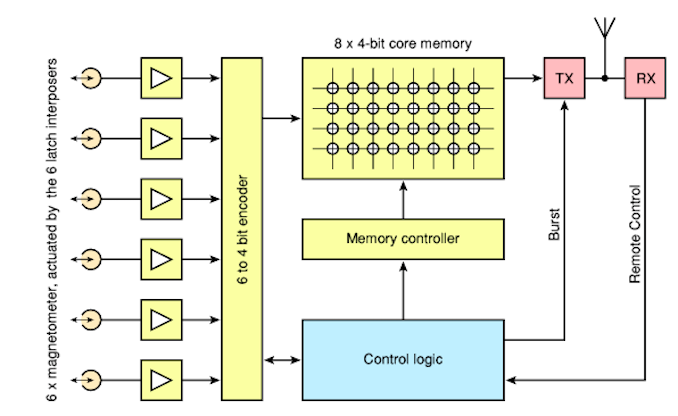 IBM Selectric was manufactured in a sturdy aluminum frame. On the front panel was a keyboard between the two side panels. Most likely, the bugs were installed in the IBM Selectric typewriters during delivery (in Poland or in Moscow), or during customs checks. As a rule, equipment for processing secret information was sent through special courier channels, but the typewriters were from the category of office furniture. To install the bug specialist was enough for 30 minutes.Depending on the version, the bug used radio frequencies in the 30, 60 or 90 MHz band, it worked in the same frequency band as the local television station, using a frequency very close to the actual (strong) television signal. The signal was on the air for very long, it could hardly be distinguished from the frequency-modulated (FM) TV signal.
IBM Selectric was manufactured in a sturdy aluminum frame. On the front panel was a keyboard between the two side panels. Most likely, the bugs were installed in the IBM Selectric typewriters during delivery (in Poland or in Moscow), or during customs checks. As a rule, equipment for processing secret information was sent through special courier channels, but the typewriters were from the category of office furniture. To install the bug specialist was enough for 30 minutes.Depending on the version, the bug used radio frequencies in the 30, 60 or 90 MHz band, it worked in the same frequency band as the local television station, using a frequency very close to the actual (strong) television signal. The signal was on the air for very long, it could hardly be distinguished from the frequency-modulated (FM) TV signal.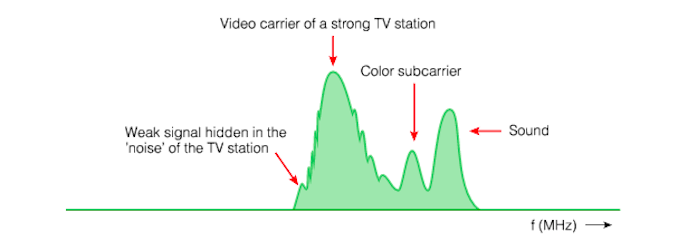 Since some bugs were not connected to a DC source, in order to avoid their detection, the tips used a low power pulse transmitter. The transmission range was limited, due to the aluminum housing of the machine, the listening post was supposed to be in close proximity to the embassy.In the USSR, constantly engaged in the improvement of bugs for many years. The NSA was able to identify five different versions or generations of such devices. A bug could track only letters, but did not fix spaces, some punctuation marks.
Since some bugs were not connected to a DC source, in order to avoid their detection, the tips used a low power pulse transmitter. The transmission range was limited, due to the aluminum housing of the machine, the listening post was supposed to be in close proximity to the embassy.In the USSR, constantly engaged in the improvement of bugs for many years. The NSA was able to identify five different versions or generations of such devices. A bug could track only letters, but did not fix spaces, some punctuation marks.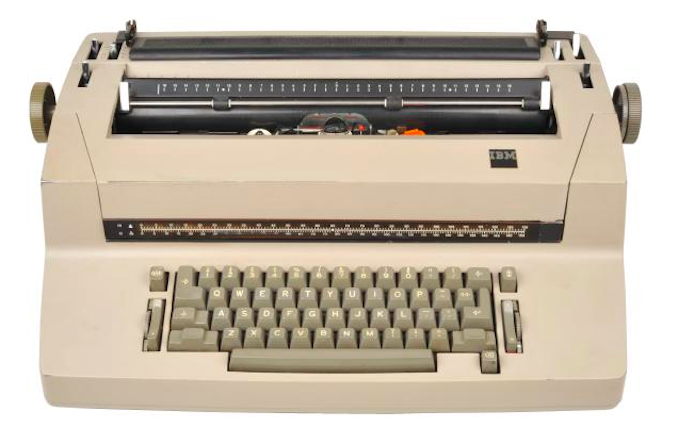 Although electric typewriters began to be produced before World War II, it was not until 1960 that they began to appear in offices. The IBM Selectric typewriter was invented in 1961 and has been a leader in the market for the next 20 years. A removable printhead allows for the use of various fonts.
Although electric typewriters began to be produced before World War II, it was not until 1960 that they began to appear in offices. The IBM Selectric typewriter was invented in 1961 and has been a leader in the market for the next 20 years. A removable printhead allows for the use of various fonts.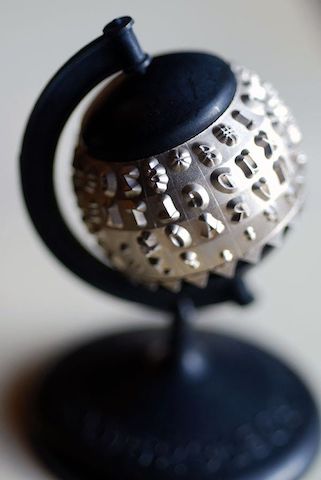 The first IBM Selectric was released on July 31, 1961. It used a writing head with 88 characters divided into 4 lines. In 1971, the world saw an improved version of the Selectric II, it had the same print head with 88 characters. In 1973, the Selectric II was followed by the Correcting Selectric II, in which the text adjustment function appeared. In the early 1980s, it was replaced by Selectric III, the print head had 96 characters. It was the latest golf ball series created by IBM.Hearing that which is not intended for other people's ears and seeing what is hidden from prying eyes - this is what all the intelligence services of various countries have been striving for at all times. With the course of history, techniques, equipment, methods of wiretaps were improved, becoming more sophisticated and less accessible for detection. Perhaps over time, interesting details will be revealed, new incidents that occurred in the past, but are still classified as “secret”.The article used materials from the most magical resource Crypto Museum .
The first IBM Selectric was released on July 31, 1961. It used a writing head with 88 characters divided into 4 lines. In 1971, the world saw an improved version of the Selectric II, it had the same print head with 88 characters. In 1973, the Selectric II was followed by the Correcting Selectric II, in which the text adjustment function appeared. In the early 1980s, it was replaced by Selectric III, the print head had 96 characters. It was the latest golf ball series created by IBM.Hearing that which is not intended for other people's ears and seeing what is hidden from prying eyes - this is what all the intelligence services of various countries have been striving for at all times. With the course of history, techniques, equipment, methods of wiretaps were improved, becoming more sophisticated and less accessible for detection. Perhaps over time, interesting details will be revealed, new incidents that occurred in the past, but are still classified as “secret”.The article used materials from the most magical resource Crypto Museum .Thank you for staying with us. Do you like our articles? Want to see more interesting materials? Support us by placing an order or recommending to friends,
30% discount for Habr users on a unique analogue of the entry-level servers that we invented for you: The whole truth about VPS (KVM) E5-2650 v4 (6 Cores) 10GB DDR4 240GB SSD 1Gbps from $ 20 or how to share the server? (Options are available with RAID1 and RAID10, up to 24 cores and up to 40GB DDR4 RAM).
Dell R730xd 2 times cheaper? Only we have
2 x Intel Dodeca-Core Xeon E5-2650v4 128GB DDR4 6x480GB SSD 1Gbps 100 TV from $ 249 in the Netherlands and the USA! Read about
How to build an infrastructure building. class c using servers Dell R730xd E5-2650 v4 worth 9000 euros for a penny?